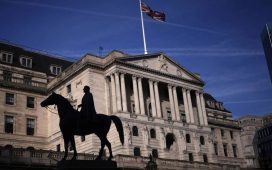The big increases in monthly mortgage costs Britons are facing “just don’t happen here”, says Roger Bartlett, who bought a home in Belgium when working in the country as an air traffic controller.
He says his experience was the same in the Netherlands, where mortgages with 30-year repayment terms are the most common loans used by homebuyers.
The rapid increase in UK mortgage rates – the average two-year fixed deal has hit 6% for the first time this year – has raised questions over how the British home lending market compares with overseas nations as interest rates rise across the globe. A picture of a comparatively short-term, highly competitive UK industry quickly emerges.
Bartlett’s first mortgage carried a 9% interest rate, but when new mortgages were beginning to be offered at nearer 4% a few years later, he paid a charge – equivalent to three months of payments – to transfer to the lower rate.
“The benefit to the customer is that you can plan your outgoings for the total period. And for society it brings stability into the market, with most lenders not being affected by the rate changes,” he adds.
Variable mortgages are on offer, but the rate is only 0.5% lower, he says, making it a big gamble for little gain.
His daughter has recently moved back to Belgium from the UK and bought a home with a 20-year mortgage, fixed at 1.49%.
As in the Low Countries, there is a strong paternalistic element to mortgage lending in France that allows homebuyers to take a punt on a 30-year fixed rate loan.
If the mortgage-payer moves home, there are no early repayment penalties. And if someone loses their job or becomes ill, the lender is expected to be lenient, says Miranda John, the director of international property finance at the broker SPF Private Clients.
The central bank cushions borrowers from the ups and downs of the financial markets, at least from its weekly mood swings, by issuing an average percentage rate (APR) that banks must use as the basis for their loans.
A state-influenced mortgage market might have the benefit of allowing borrowers to adjust to higher borrowing rates over a longer time period, but it means that in a period of quickly rising loan costs, the lag between what banks can offer and what they must pay themselves to borrow on international markets is squeezed. The average 30-year mortgage rate in France is still 3.5%.
John says French borrowers might, in theory, be enjoying much lower borrowing costs than their counterparts in the UK, but the reality is that most banks are not lending because their margins are squeezed to the extent that they would be making a loss.
“A standard APR was introduced by the central bank as a consumer protection measure, but it has stalled the whole market at the moment now that ordinary mortgages are not profitable,” she says.
Culturally, it means the French system is a world away from the UK mortgage market, which has about twice as many lenders vying for business and many times more products on offer.
In the US, a more long-term approach to mortgages has prevented households facing an immediate jump in borrowing costs. While steep interest rates rises and political instability have caused tremors in the mortgage market, the popularity of mortgages that are fixed for the full 15-year or 30-year term has shielded homeowners.
The average US mortgage term is 23.3 years and shows no sign of shortening in response to rising rates. A similar level of flexibility applied by continental banks is offered to buyers in America should their circumstances change.
The lowest rate for a 30-year mortgage in the US is about 5.7%.
In the UK, mortgagers are also encouraged to buy short term by a finance industry populated by many more brokers than can be found in France and standard rules that allow mortgage companies to apply early redemption charges on those who want to bail out of a long-term fixed rate product.
Financial stability is another hurdle UK mortgage lenders must overcome, says Neal Hudson, founder of the consultancy Residential Analysts and a visiting fellow at the Henley Business School.
“The financial markets are paying attention to UK data at the moment and it is proving disappointing,” he says.
Official figures on Wednesday are expected to show only a modest fall in inflation in May, forcing the Bank of England to raise interest rates for a 13th consecutive time to 4.75% when its policymakers meet on Thursday.
However, fixed-rate mortgages are tied to the market in government debt. The interest rate on government debt, known as the yield, soared last year in the wake of Kwasi Kwarteng’s ill-fated budget and has returned to high levels in recent weeks.
Financial markets have judged that the UK’s recovery from the pandemic and inflation crisis will take longer than many other countries, leading analysts to believe that mortgage rates will stay at current levels well into 2024.
France and the rest of the 20 countries inside the eurozone face rising borrowing costs after a series of rate rises by the European Central Bank, but the stability of the currency zone means that the interest rate on government debt remains below the UK’s.
Portugal is an outlier. It has the highest effective mortgage interest rates, which is a measure of all mortgages and the interest bill paid, mainly because the majority of homebuyers buy variable-rate products.
Ray Boulger, a mortgage adviser at the broker John Charcol, says niche lender Kensington Mortgages plans to launch a 30-year fixed-rate mortgage in the UK at 5.65% later this year. Like its French counterparts, it will not make early redemption charges for moving house. It hopes it will catch on.
“About 40% of mortgage buyers opted for variable rate mortgages in the fourth quarter of 2022. They will be having a tough time,” he says.










